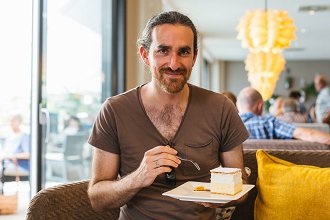Beyond the Cream Cake: A Foodie Day Tour of Bled
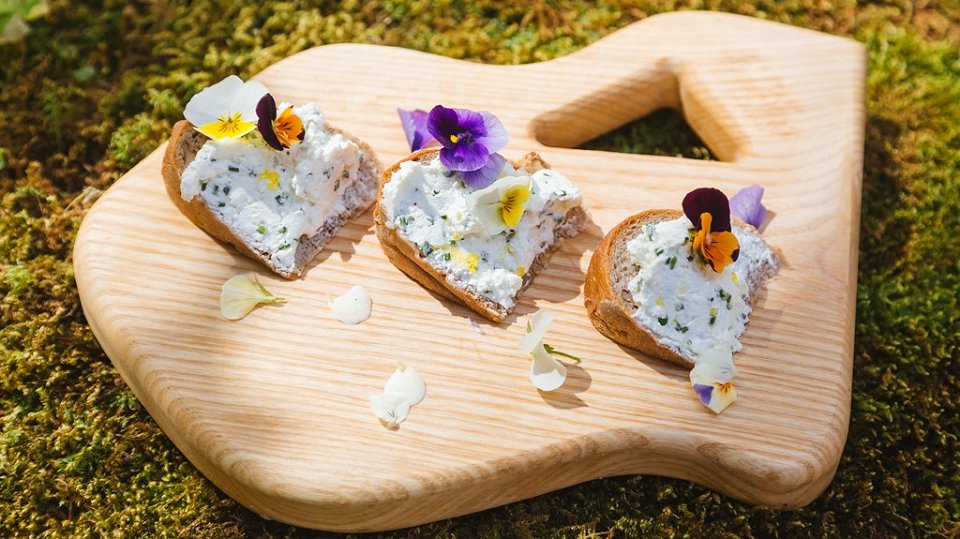 © Boris Pretnar
© Boris Pretnar
Mark my words, you will eat the Cream Cake. Oh yes you will eat the famous Bled Cream Cake, and you will love every moment of it. Of course, you must, because it is the thing to do. It is also completely delicious and a culinary delight that is worth a journey. But the Bled Cream Cake is so well-known that it is almost a cliché. That’s okay—there’s a reason why tens of thousands of people every year come to Bled, to admire the views, enjoy nature and eat the local specialty they’ve heard so much about. My family has always looked forward to holidays based on things we were excited to eat—we once drove four hours, from my home in New Haven, in the US, to Baltimore, just to try a local French fry (we filled the backseat of the car with three buckets full and drove back in a state of fry-induced bliss). We would eat our way around the world, and the rest of what we did on holiday was just killing time between meals. We’re the sort of family that would get in an airplane and fly to Slovenia just to eat Bled Cream Cake. So yes, when you are here, eat it—you’ll love it.
But it turns out there's a lot more to the gastronomic cultural heritage of Bled. The cream cake is just the tip of the creamy and multi-layered metaphorical iceberg. If I'm flying all the way to Slovenia, even if my primary focus is eating a slice of Bled Cream Cake (or five), then I want to know what else I can eat while I happen to be on location. There are three meals in a day (or, to be honest, there can be as many as you want there to be), so there is plenty of time to taste the local wares. And one of my favorite things to do is not just taste what is hyper-local, but also to meet the people who make it and hear the stories behind the dishes.
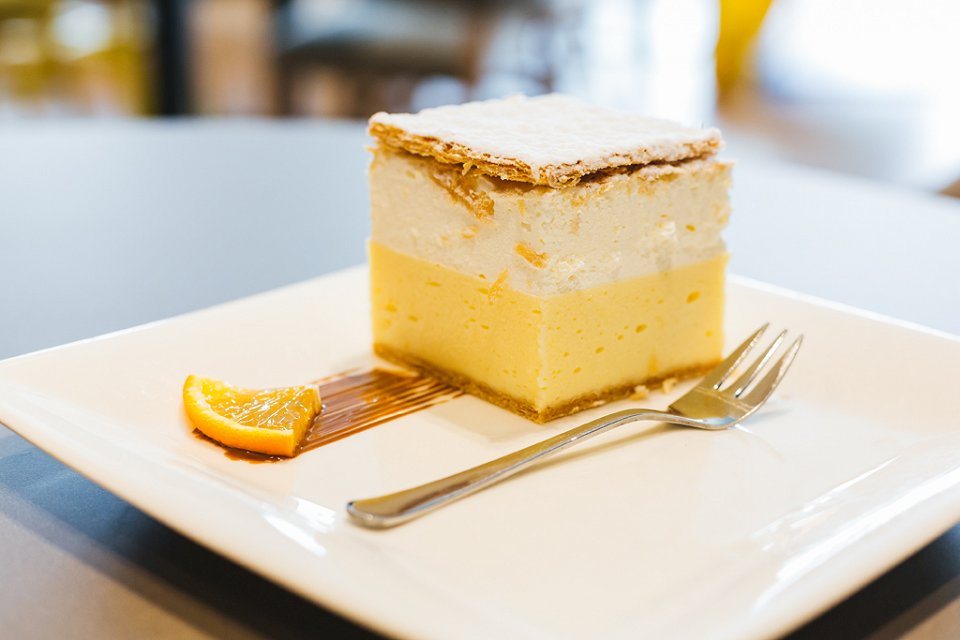 © Boris Pretnar
© Boris Pretnar
It’s my kind of party to set out and explore the gastronomy of Bled beyond the famous cream cake. The Bled Tourist Board arranged one very full day for me to do so, complete with six stops, only one of them in the Bled town center, where most of the tourists gather. The center will surely be where you will find yourself for most of your visit to this most majestic of locations in Slovenia, but I was keen to go beyond the ridiculously photogenic castle and the church-topped island. Just as New York City is more than just Broadway and the Statue of Liberty, so too is Bled more than just its main tourist attractions. I wanted to eat my way through local specialties that I had never heard of before, and so the photographer, Boris, and I set out on one of the first blazing hot summer days of the year, with a map in hand, six key locations circled by our tourist center contacts, in a loop around the periphery of Bled.
Garden Village Bled
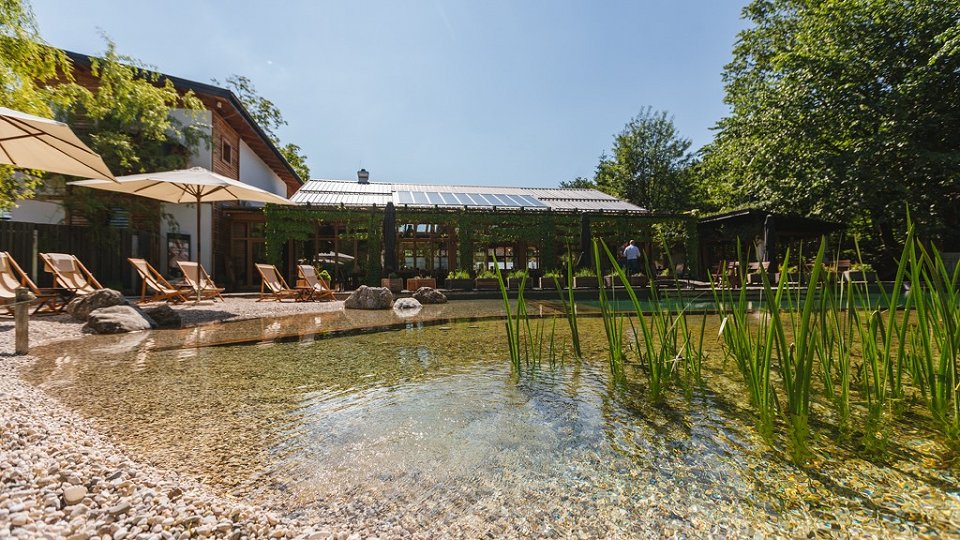 © Boris Pretnar
© Boris Pretnar
The first stop was at the Garden Village Glamping Resort. Though it’s just a stone's throw from the shores of the lake, it feels like you’ve been transported to a remote forest location, where you get to live out your childhood fantasies of fancy camping in a treehouse. There are a variety of different upscale glamping spaces in which to stay at this resort: there are low-slung tents down at the bottom of a gorge, perched on stilts above a stream that carries water from the lake in soothing burbles. A little bit higher up the slope stand two-story tents made mostly of wood and 100% cotton tarps (no unnatural materials used) and outfitted like free-standing lux hotel rooms. The only nod to camping comes in the form of communal bathrooms. But the piece de resistance is the treehouse offering, six majestic two-story wooden structures literally nestled in the trees. I could imagine my 4 and 6 year old daughters going nuts with delight at the idea that they could live in a treehouse especially, when the upper story of house consists mostly of an indoor trampoline net that you can lie on (or indeed jump on). The honeymoon suite, the fanciest of the bunch, comes complete with a drawbridge which, as the marketing manager of the hotel, Bogdan Capuder, joked was convenient not only so that you will not be disturbed, but also so the groom would have no way of escaping the clutches of his beloved on their wedding night. It truly feels like a resort that you might find by the sea. There is a fire pool in which you can bathe, with a pebbly beach leading down to it, ringed by lounge chairs, and a fire pit which is stoked every night so that you can take your glass of wine and sit around it, to relax with your fellow guests.
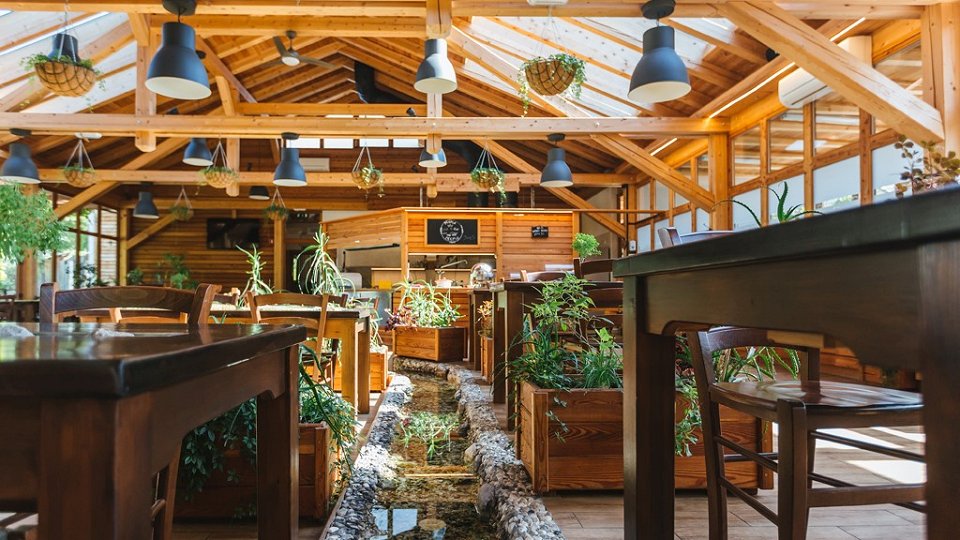 © Boris Pretnar
© Boris Pretnar
The restaurant is open even if you are not staying there and is distinctive, if not unique, in the world. A stream literally runs through it along the floor and each table is covered with fresh growing grass, upon which your meal is served. Rather than flowers in pots on tables, you can find live herbs and even lettuce. When the manager ordered us a round of elderflower juice, the waiter walked from table to table, gathering a handful of fresh herbs to mix in. Everything served is hyper-local If you are a locavore, then this is the place for you. The resort is lush with fruit trees and has their own vegetable gardens, so that everything possible is made on-site. They also have a zero waste program: all organic scraps are fed to local, indigenous Blackstrap pigs (renowned as the best in the world for prosciutto and other delicacies in which high fat content is desirable), which are then ultimately fed to the guests, in a beautiful edible circle..
Garden of tastes
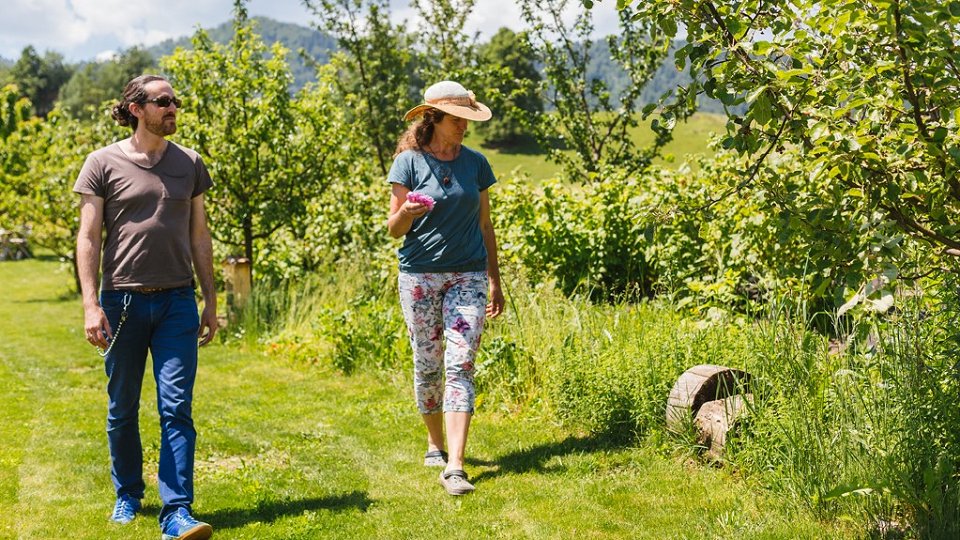 © Boris Pretnar
© Boris Pretnar
Boris and I drove to a village just outside of Bled, where the elegant Mateja Reš greeted us literally in her own backyard, a perfectly-manicured lawn set against the backdrop of a church in the near-ground and the Alps a bit further beyond. Beneath a covered terrace stood an outdoor kitchen at which her son was separating the stems from elderflowers which grew a few meters away. Mateja is perhaps best-known as the creator of Bled teas, which are sold throughout Bled. They vary in their ingredients based on what is seasonal in mountain pastures in the area and in her elaborate garden. Small quantities are a must, because Mateja gathers everything by hand and dries it herself.
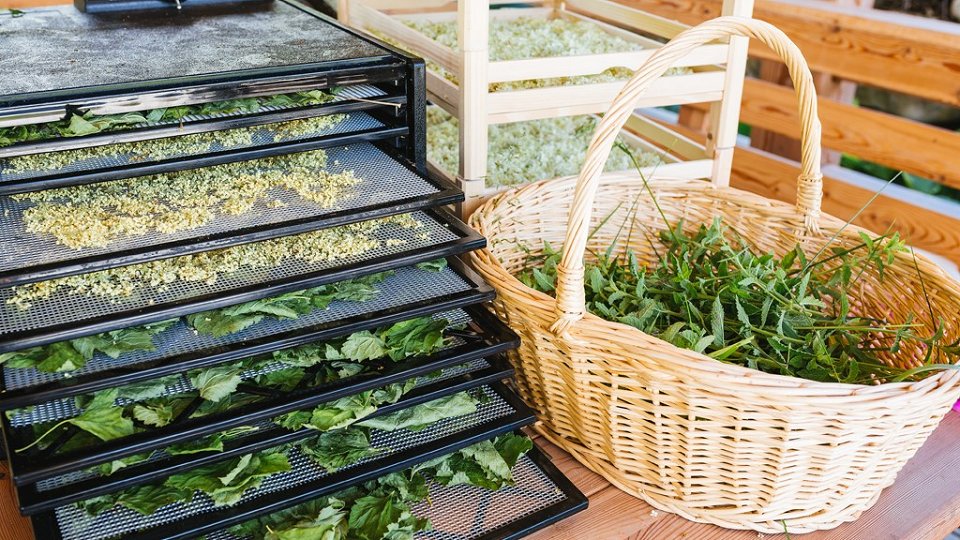 © Boris Pretnar
© Boris Pretnar
This means that her knowledgeable hands have selected and prepared every leaf and flower that goes into her products. She offers culinary experiences for visitors in a variety of languages and based on the preferences of the guests, who may want a workshop on local herbs and flowers, or to learn to make traditional cakes, like the national pastry, potica, or even have a cookout. Across the street from her home, with her adorable dog frolicking alongside us, meanders a labyrinth decorated and edged with various local flowers and herbs. She encouraged us to walk the spirals of the labyrinth and breathe in the scent of the herbs warmed by the sun, in a form of herbal meditation.
Prgarija - Tepka pear village Zasip
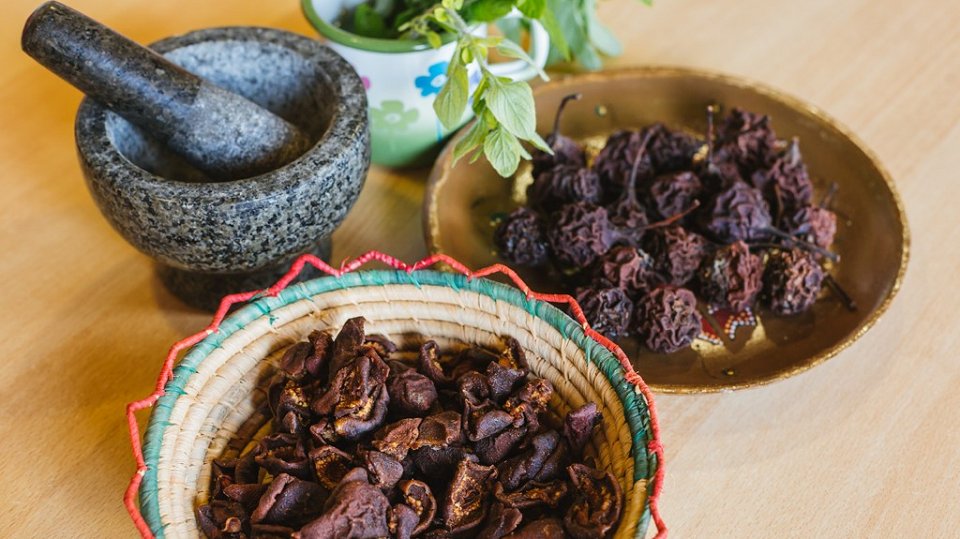 © Boris Pretnar
© Boris Pretnar
Off we went to the nearby village of Zasip which Slovenia’s most famous poet, the Romantic France Prešeren, called “the altar of Gorenjska,” the spiritual heart of this mountainous region of Slovenia. But it is colloquially known as Prgarija, with its claim to fame being the multifaceted use of a special type of pari, tepka, which is indigenous to Slovenia and Austria. When these pears are dried, they are calledprga, so the nickname of the village, Prgarija, might be translated as “Dried Pear Land.” I could tell I was going to like it—any location known for a single, superior specialty is far more exciting for me than a place of general qualities. As I teach in my writing classes, specificity and, if we’re honest, quirkiness is always more memorable and attractive than the generic. So, a tiny village known far and wide for dried pears? I was in!
The story goes that 18th century Habsburg Empress Marija Terezija sought to limit famine by planting crops, particularly in poor areas, and one of the staples were tepka pear trees. The area around Bled and Zasip was so poor that sometimes all they had was this abundance of pears, and the innovative locals had to come up with myriad ways to use them. This village became Ground Zero for preparing a huge variety of dishes based on this very special type of pear. The best-known creation is tepkovec, schnapps made of fermented and distilled pears, but that is only the starting point. Once the pears are dried, and become prga,then they are used in a huge array of dishes, savory and sweet alike. The key to this is the trick of grinding the dried pears into a powder that can be used instead of wheat flour. Bread is baked from it, as are a variety of pastries. The prga are processed through meat grinders, then walnut grinders, to produce the fine “flour,” and then the only limit in how to use them is the imagination. Thankfully, Bojana Pipan has imagination in spades. The godmother of cooking with prga is such an adorable grandmother that my first question for her, as a visiting journalist, was whether I could give her a hug. (I'm pleased to say that she accepted.)
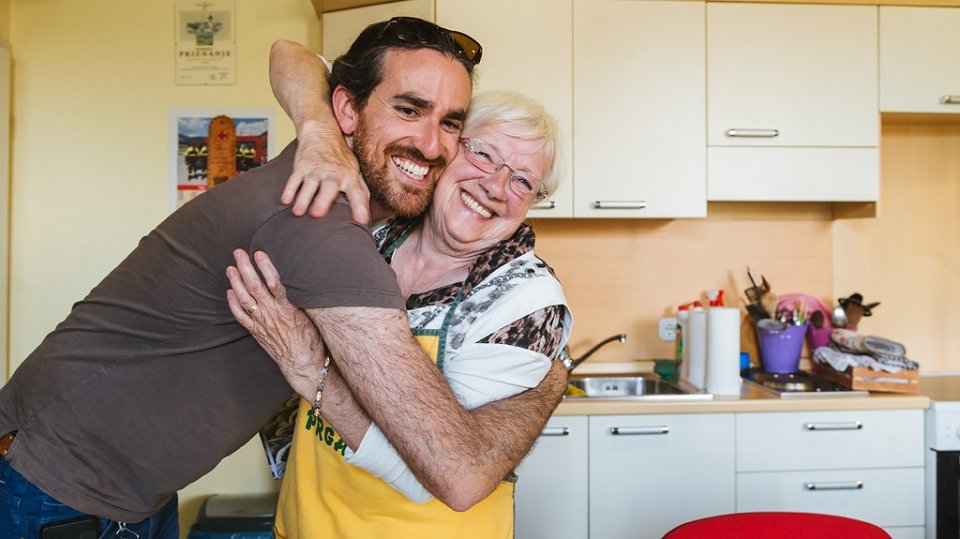 © Boris Pretnar
© Boris Pretnar
Turns out she had made us a smorgasbord of delights that feature in her cookbook which, as you’ll have guessed by now, includes prga as a key ingredient in every recipe. She offers workshops for adults and children and getting a hug from her is worth the journey (I’m not sure if the hugs come standard with her workshops—best if you ask in advance).
If people in Slovenia have heard of these pears, and a surprising number have not, despite their local fame, then they have encountered them as the basis for that particularly delicious pear schnapps, tepkovec. The Trglav family farm stands a few hundred meters from the center of Zasip. When we arrived, Boris and I were greeted by a steep slope dropping off behind the Trglav house lined with these pear trees, some of them growing to colossal size. They are harvested and once a year in great quantities and are cooked to make schnapps.
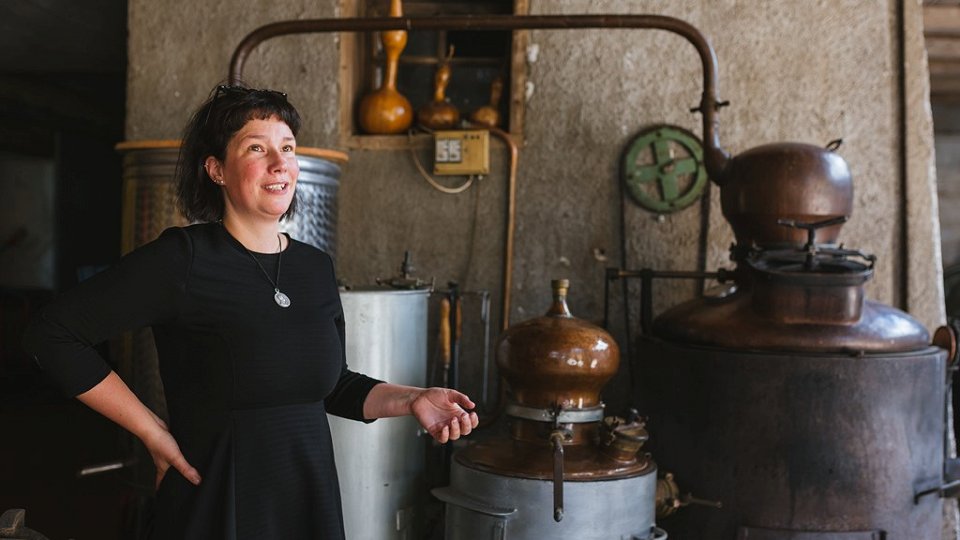 © Boris Pretnar
© Boris Pretnar
The fresh pears are minced in a machine and left to ferment for 6 months in barrels. They are then cooked twice in an old-fashioned still—the first distillation is too high in alcohol, but the second renders it just right. From this foundation, which is delicious as is, the Trglav family produces more than thirty different flavors of schnapps, from traditional versions like Smrekovec (flavored with soft, young spruce tips) and Slivovec (flavored with plums) to more exotic fare (echinacea, grapefruit, carob and even chocolate and mint). Andreja, the daughter of the family, invited us into their farmhouse and down a set of stairs, past a “black kitchen,” blackened from centuries of smoking meats and baking delicacies in an indoor wood-fired oven. That scent of smoke lingered delightfully as we traveled down another set of stairs to arrive in the root cellar.
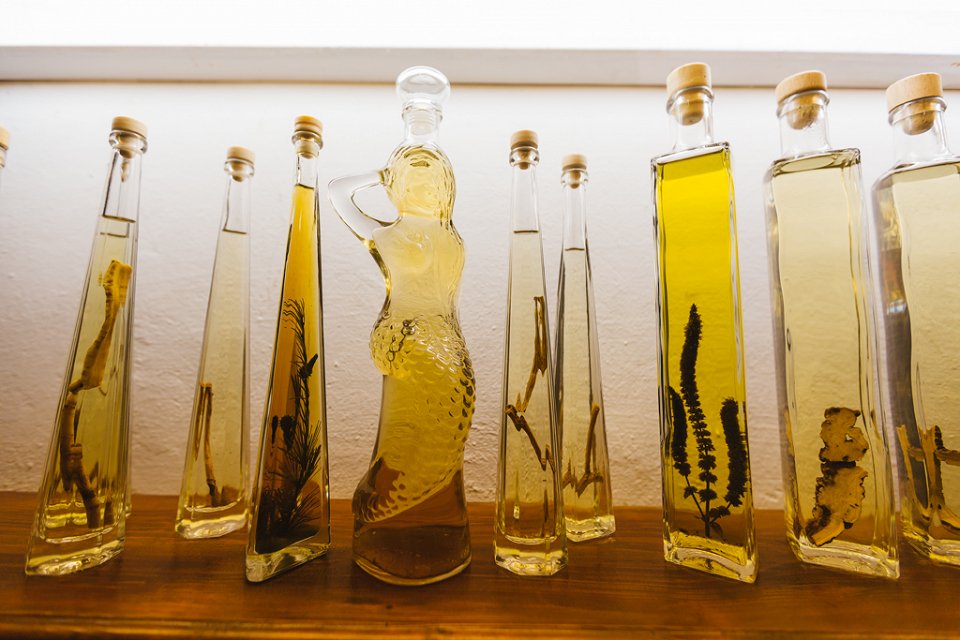 © Boris Pretnar
© Boris Pretnar
If Heaven has a root cellar, then this is what it would be like. The old stone walls and dirt floor were lined with bottles of schnapps. If you enjoy good liquors, then this is where you’ll want to curl up for a while. The cave-like interior is covered, floor to ceiling, with schnapps of all varieties, some of the bottles looking straight out of an alchemist's laboratory. Long, slender bottles, bottles shaped like a bear or a skull, and some of them bearing a large tepka pear floating inside it. The tradition is to attach the bottle to the tree branch and around the pear when it is small enough, thus allowing it to grow to full size inside the bottle. The result is like a ship in a bottle trick, but for real party animals. But this would not just be a “liquid lunch.” There, laid out on a slab of stone, were Bojana’s culinary creations for us to taste. It's a good thing, too, because we were given a variety of schnapps to try and this on an empty stomach. Slovenes show their hospitality by offering guests a shot of homemade schnapps, and Boris and I had no intention of being less-than-ideal guests. That means we were “obliged” to taste many, many schnapps. Sometimes my work doesn’t feel like work.
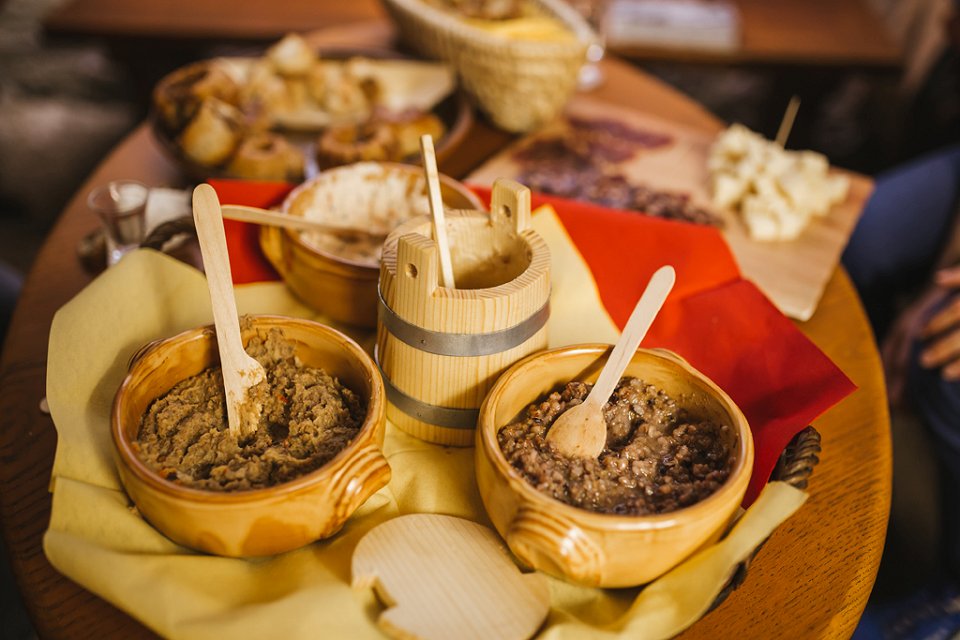 © Boris Pretnar
© Boris Pretnar
Boris and I could barely conceal our delight, as we tucked into Bojana’s creations. There were three different spreads: with barley and lentils, another with a local curd cheese, the third with beans and bits of pork. There was fresh bread made with pear flour, and studded with bits of pear, and there was even potica, the national pastry, likewise made with—you guessed it—dried pear flour. With more time and without having to worry about picking up my daughters from kindergarten later on, I could have easily parked in this root cellar for the whole day and tasted my way through the complete offering of schnapps, fortified by prga-fueled delicacies. Visitors can have the same experience as Boris and I enjoyed, if they book ahead, and you can also take home bottles of Trglav schnapps, as many as you like (and depending on how much room is in your suitcase). I encouraged Andreja to consider making travel schnapps bottles for tourists. Homemade schnapps is one of the best things to take home, but few want to fly with glass bottles clanking around. When friends come to visit, we pour my grandmother-in-law’s village-champion schnapps into empty water bottles, wrapped shut with duct tape, so they can easily fly home in checked-in luggage. It’s a bit of a “ghetto” trick, but it works. Whoever invents the take-home schnapps bottle for tourists will be on the road to success.
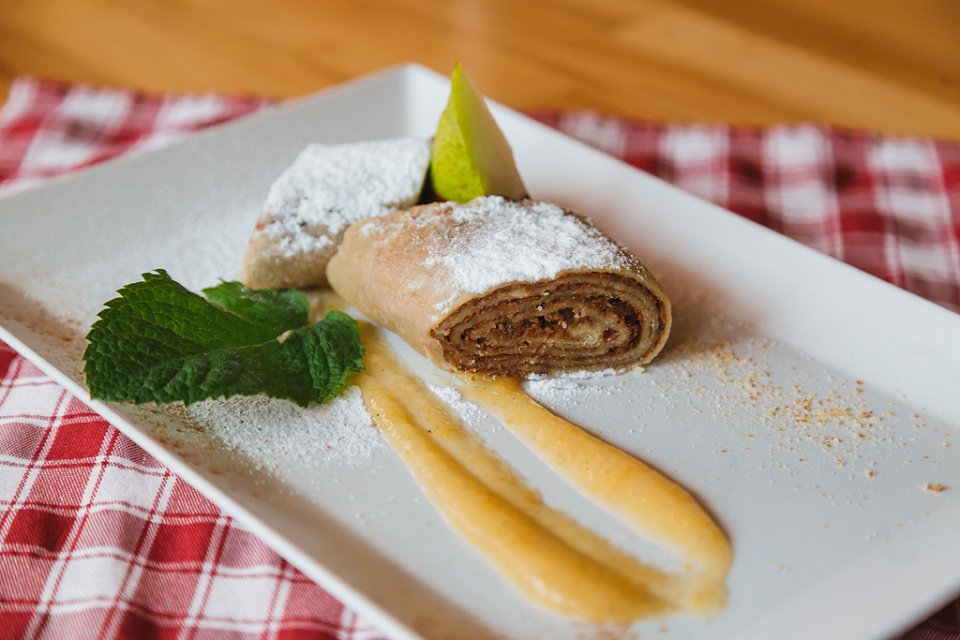 © Boris Pretnar
© Boris Pretnar
The story of this village, with its famous dried pears, continued at the local inn, Gostilna Kurej, where they feature a special recipe from Bojana’s cookbook: a national specialty, štruklje. Which I never know how to translate, as the exact dish doesn’t really exist in the anglophone world. Štruklji (pronounced “shtrook-lee”) are made of thin dough into which a filling is laid, before the dough is rolled tightly into a tube, wrapped in cloth, and cooked in boiling water. It is then sliced, so that it resembles a roulade, but it is lighter and thinner than what you’re probably imagining. There are savory and sweet varieties, and Bojana’s prga štruklji are sweet, packed with pear and served with a side of pear sauce, plus a slice of the fresh pear dipped in chocolate. If this pear-tastic experience sounds somewhat repetitive, I should emphasize that it is not. The cornucopia of things that you can do with fresh and dried pears mirrors the myriad of experiences you can do with other “master ingredients,” like rice or wheat or potatoes or beans. The sky is the limit and I love the fact that this is not only local to Slovenia, but hyperlocal to a single village. You, as a tourist, can get an experience so specific and yet rich in tradition that most Slovenians have never tried it. The biggest surprise is that it happens to be just five minutes from Bled, the most-visited tourist site in the country, yet only the sharpest of travelers think to come here. You can take a class on cooking with Bojana (hugs optional) and taste the delicious pear schnapps and delicacies at the Trglav farm and sample the štruklji and have an experience that even locals would be envious of..
Life doesn't get much better than this. But now Boris and I should probably go for a run around the lake a few dozen times to work off the day’s delights, because the next stop…you guessed it…is Kavarna Park for that legendary Cream Cake.
About author
Dr. Noah Charney is a best-selling American author and professor of art history, living for many years in Slovenia. He grew up in New Haven, in the USA, and did his postgraduate studies at The Courtauld Institute, University of Cambridge and University of Ljubljana. He is the author of 13 books, including several international best-sellers, including Slovenology: Living and Traveling in the World's Best Country, a book of essays about his adventures living in Slovenia, which he calls “the world’s best country,” which sold over 3000 copies in the first six months. HisEternal Architect: The Life and Art of Joze Plecnik, Modernist Mystic, came in second for the Slovenian Book Award and won Best Book at the Novi Sad Architecture Biennial. While he is a specialist in art history and art crime, he has become a specialist in Slovenia, writing about it frequently for major publications, like The Guardian and the Washington Post. Learn more about his work at noahcharney.com or join him on social media, where he reports on his adventures in "the world's best country.".

